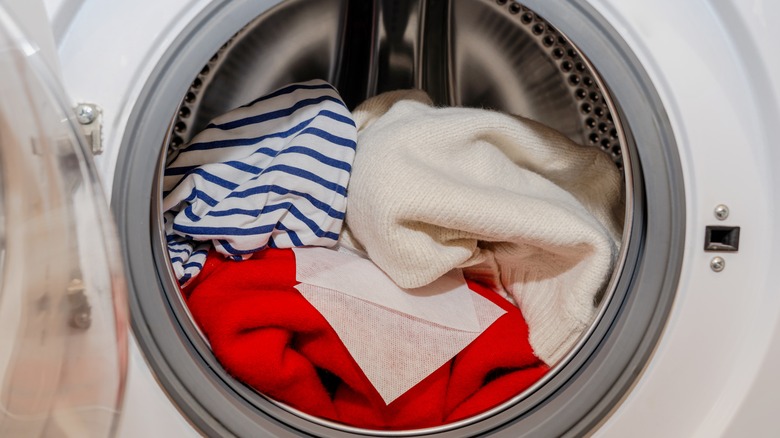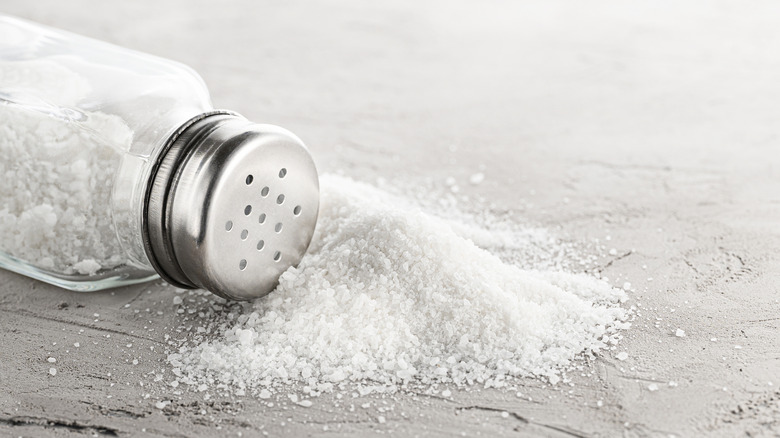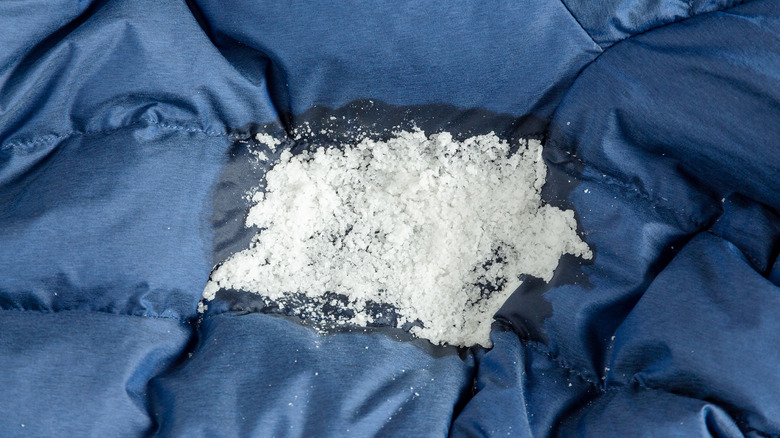The Kitchen Essential That Can Work Wonders In Your Load Of Laundry
Ordinary table salt, something that's most likely already in your kitchen, can double as an effective laundry booster when used correctly. Salt works in a few ways to improve your washing results. It helps set dyes in colored fabric to prevent fading, softens hard water which enhances detergent performance, and even acts as a gentle abrasive to work on stains. The sodium chloride in salt alters the water's chemistry to create an ionic environment that helps dirt particles separate from your clothing more effectively during the wash cycle. It's also an eco-friendly alternative to commercial laundry additives that can often contain harsh chemicals. Salt is gentle on both the fabrics and your skin.
You can lock in dyes by adding salt to the first few washes of new, brightly-colored towels and clothes. In areas with hard water, it prevents mineral deposits from leaving clothes looking dull by binding calcium and magnesium ions. Salt also proves rather effective on certain stubborn stains when used as a pre-treatment paste. One of the lesser expected benefits is that adding salt to your wash can actually reduce static cling in synthetic fabrics by improving the conductivity of the water. This results in softer, less clingy clothes straight out of the dryer. All these benefits make salt one of the most versatile, and often overlooked, laundry additives available.
How to harness salt's laundry powers
Mixing in salt with your laundry routine is an easy process, but does require some specific measuring and timing to make it effective. For general color protection and water softening, add ½ cup of plain salt directly into the washing machine before loading your clothes. This will allow some time for the salt to dissolve fully during the fill cycle. When adding in new colored items that may bleed, create a saltwater soak using salt and cool water and leave the garments to soak for 30 to 60 minutes before their first wash. Salt can also remove some of the toughest fabric stains — just make a thick paste with salt and cold water. Gently rub it into the stain and let it sit for about 15 minutes before adding it to the wash as normal.
There are some other techniques you could use to enhance the use of salt in your laundry. Combine it with vinegar in the rinse cycle for a little extra brightening of whites. You can use coarse sea salt as a gentle scrub for collar and cuff stains on stronger fabrics. If you have a front-loading machine, dissolve the salt in a cup of warm water before adding it. This will prevent the salt from getting into hard-to-reach areas and leaving a residue. It's important to match the water with what you're trying to accomplish with the salt. It dissolves best in warm water but cold washes with salt provide a better dye-setting benefit. These methods should work fine in both standard and high-efficiency machines, but you may need to adjust the amount of salt used in smaller HE loads.
The potential downsides of salt as a laundry helper
While salt offers many benefits for your laundry, certain situations may require a little caution. Delicate fabrics like silk or wool can get damaged by salt's abrasive nature, especially in concentrated stain treatments. Repeated use in hard water areas may also lead to residue and buildup if not balanced with the occasional vinegar rinse. If you've got a front-loading washer you'll need to be extra diligent about running the occasional cleaning cycle to prevent any salt residue from building up in the machine's gaskets and dispensers.
Environmental considerations should also come into play. Salt is a natural element but excessive use in laundry can contribute to the sodium levels in wastewater that can impact aquatic ecosystems. As with anything else, moderation is key. Some modern detergents already contain water softeners making salt an unnecessary additive unless you're dealing with extremely hard water. If using salt just doesn't sit right with you, you can add baking soda to your laundry and it offers some of the same benefits without any sodium concerns. Always be sure to test salt on a small area of fabric before committing to a full treatment; some dyes may react in unexpected ways despite their color-protecting reputation.


